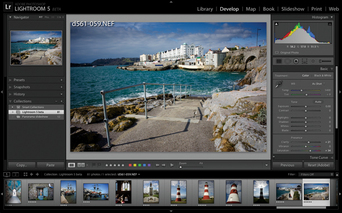Adobe Lightroom: The most powerful way to organize and edit your photos!

Lightroom has profoundly improved my life as a photographer.
Lightroom combines vital features under one umbrella: organization, workflow, non-destructive editing, real-time editing, seamless integration with Photoshop, local adjustments without using layers, plug-ins for web publishing, Blurb integration for book layouts, and much more.
Working with tens of thousands of images in Lightroom is like a hot knife through butter. By streamlining the tedious aspects of image management and editing, Lightroom enables you to concentrate on what you really want to do: enjoy the creative process of working with your images.
Since its introduction in 2006, I’ve used Lightroom on a daily basis — please feel free to visit my photography portfolio and my Instagram account to see examples of images I’ve edited in Lightroom. Also check out the wealth of information about Lightroom provided by Adobe.
Lightroom combines vital features under one umbrella: organization, workflow, non-destructive editing, real-time editing, seamless integration with Photoshop, local adjustments without using layers, plug-ins for web publishing, Blurb integration for book layouts, and much more.
Working with tens of thousands of images in Lightroom is like a hot knife through butter. By streamlining the tedious aspects of image management and editing, Lightroom enables you to concentrate on what you really want to do: enjoy the creative process of working with your images.
Since its introduction in 2006, I’ve used Lightroom on a daily basis — please feel free to visit my photography portfolio and my Instagram account to see examples of images I’ve edited in Lightroom. Also check out the wealth of information about Lightroom provided by Adobe.
For personalized Lightroom coaching,
call or text 917.502.8870 or email me
I’ll teach you how to work with your images in Lightroom
- Import existing images from iPhoto, Photos, Aperture, or any other app or location
- Set up routines for naming and organizing new images imported from your camera
- Create presets for applying image effects or any other setting
- Batch processing
- Adjustments, retouching, cropping, corrections -- many artistic considerations
- Sync with Lightroom Mobile on iPad and iPhone
- Easily publish to Instagram, Facebook, Flickr, Zenfolio and other services
- …and much more!
I’ll answer all of your questions about Lightroom
- Which is best for me, Lightroom Classic (desktop) or Lightroom (cloud)?
- Why are some of my photos missing, i.e. displaying an exclamation mark icon?
- Where are my photos stored?
- Why did my photos end up in a completely unexpected folder?
- Can I edit my Lightroom images in Photoshop?
- How do I use collections and keywords?
- I have too many photos and am running out of space on my Mac — what do I do?
- Can I email photos directly from Lightroom?
- Why do I have multiple catalog files?
- How do I back up my Lightroom catalog and all of my photos?
- …and many others!
For personalized Lightroom tutoring,
call or text 917.502.8870 or email me
Lightroom compared with other apps
Photos — Apple’s successor to iPhoto has some great new features, such as syncing your entire library across multiple devices through iCloud, and the ability to edit your images in third-party apps.
Aperture — Once a competitor of Lightroom, Aperture was discontinued in 2015, when Apple focused its development efforts on Photos. Apple and Adobe have provided a tool that enables users to migrate their Aperture libraries to Lightroom.
Adobe Bridge — Before Lightroom, Bridge was a reasonable solution for organizing and keywording your photos, but actual editing was performed with an external app of your choice. Now that we have Lightroom, there’s really no reason to use Bridge anymore.
Adobe Photoshop — The absolute pinnacle of digital image editing software, but with a steep learning curve to match, it offers no means of organizing your images. You’ll find that Lightroom meets most of your image editing needs, but when you do need Photoshop for advanced techniques, it’s perfectly integrated for “round-tripping” with Lightroom.
Aperture — Once a competitor of Lightroom, Aperture was discontinued in 2015, when Apple focused its development efforts on Photos. Apple and Adobe have provided a tool that enables users to migrate their Aperture libraries to Lightroom.
Adobe Bridge — Before Lightroom, Bridge was a reasonable solution for organizing and keywording your photos, but actual editing was performed with an external app of your choice. Now that we have Lightroom, there’s really no reason to use Bridge anymore.
Adobe Photoshop — The absolute pinnacle of digital image editing software, but with a steep learning curve to match, it offers no means of organizing your images. You’ll find that Lightroom meets most of your image editing needs, but when you do need Photoshop for advanced techniques, it’s perfectly integrated for “round-tripping” with Lightroom.

